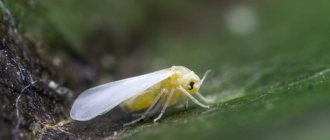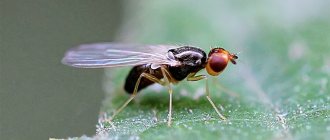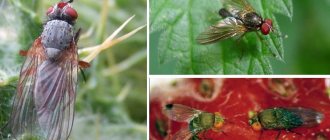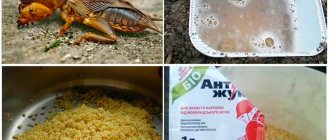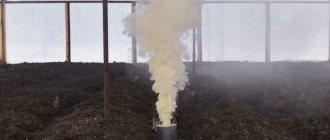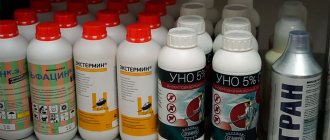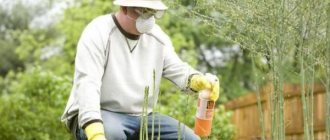Why is it dangerous for whiteflies to appear in a greenhouse?
The whitefly is a small insect of the order Aleurodidae. Externally, it looks like a moth or midge 2-3 mm in size. The body is greenish-white, covered with a whitish coating. It has two pairs of white opaque wings and a small proboscis. With its help, the pest feeds on the sap of young plants. It can often be seen in beds with cabbage or cucumbers. The whitefly multiplies extremely actively in greenhouses where tomatoes are grown.
It is especially dangerous in the summer. On hot days, no more than 3 weeks pass from laying eggs to the appearance of sexually mature individuals. And if the insect lays eggs mainly in the soil, then the larvae with rounded translucent bodies of a greenish or yellowish tint form colonies on the inside of plant leaves. They also feed on plant sap.
For vegetable crops, the rapid proliferation of whiteflies threatens death. The leaf blades turn yellow and curl, the plant slows down in growth, and the formation of new inflorescences and ovaries is reduced.
Attention! During their life, whitefly larvae secrete a sticky, sugary substance. It becomes a place for the development of sooty fungus. First, a white coating appears on the leaves, turning into black or brown spots. As the disease progresses, the fruits are also affected. Thus, gray-black small spots appear on tomatoes. Vegetables do not have time to ripen and lose their commercial qualities.
The peculiarity of the whitefly is that it settles in the greenhouse at the beginning of the season. The first to suffer is the planted seedlings. Therefore, experienced vegetable growers recommend inspecting the plantings 10-15 days after planting the plants in the greenhouse. It is difficult not to notice the insect. White moths flying up from the leaves and their larvae on the back of the leaf blades should be on your guard.
How to detect the presence of whiteflies
The insect has an original appearance, so it is simply impossible to confuse it with others:
- The body is light green, and the wings are milky white.
- Superficially it resembles a moth, but has a more elongated body, 1-3 mm long.
- Whitefly larvae may have a yellowish or gray tint, and their mobility depends on the period of the life cycle.
Interesting! The pest feeds on plant sap and moisture concentrated on its leaves. Thus, the latter does not receive enough nutrients, slows down in growth and begins to fade.
Most often, the whitefly is concentrated on the lower part of the leaves, so identifying a newly founded colony is not so easy. Only after 2-3 days of infection the pest begins to emerge in abundance on the upper side. Affected foliage takes on the following appearance:
- Distinct yellowish spots begin to appear.
- First, clumps of dense cobwebs appear on the lower and then on the upper parts of the leaves. It cannot be confused with the rare, transparent spider web.
- The plant becomes covered with a kind of sticky film, on which dust and the remains of dry leaves collect.
What to do in a greenhouse in the fall if a whitefly appears in it
You shouldn’t wait until autumn to start fighting the pest. There is a high probability of being left without a harvest. In the fall, greenhouses are finally treated for whiteflies and more to prevent re-infestation next season.
Timing for treatment of greenhouses against whiteflies in autumn
Treatment of the greenhouse in the fall, if there is a whitefly in it, is carried out as soon as possible after the final harvest. The fact is that most drugs do not affect egg laying. This means that 2 or even 3 treatments will be needed, which must be completed before the onset of frost. This is the only way to destroy the entire population.
Preparing the greenhouse for processing
Before you start treating a polycarbonate greenhouse in the fall against whiteflies, it needs to be prepared for this process.
After harvest:
- remove all plant remains, fallen fruits, branches, leaves;
- remove auxiliary equipment, ropes for tying or supports;
- remove rhizomes;
- carefully weed out weeds;
- wash all surfaces of greenhouses both inside and outside with a solution of laundry soap at the rate of: 1 grated bar per 10 liters of water;
- metal structures are treated with a solution of copper sulfate or kerosene;
- wooden parts or supports are whitewashed.
After preparatory activities, the soil is dug up to a depth of 30-40 cm.
How to prevent it from appearing
Actions related to the fight against whitefly should begin in the fall, immediately after harvest. To do this, you need to completely remove plant debris from the greenhouse. This way you will reduce the likelihood of the pest getting into the ground, where it can easily overwinter and wait until spring.
In the spring, at the seedling propagation stage, do not place seedlings next to home crops. The whitefly loves geraniums and pelargonium, from where it moves to young shoots, and with them ends up in the greenhouse. Therefore, try to ensure that indoor flowers and seedlings of tomatoes, cucumbers, and peppers are located on different windowsills.
How and how to treat a greenhouse after whitefly in the fall
When treating soil and greenhouses in the fall against whiteflies, it is worth remembering that, as a rule, adults and larvae die before they pupate. In addition, the insect has such a feature as addiction to many drugs. In the fight against the pest, comprehensive measures must be used.
Treating a greenhouse against whiteflies in the fall with chemicals
To treat greenhouses in the fall against whiteflies, contact insecticides are used, or preparations that destroy harmful insects when they come into contact with them. The most popular among gardeners are “Arrivo”, “Apache”, “Decis”. Good results are shown by the drugs “Actellik” and “Aplaud”, which also affect insect larvae.
Whitefly growth stages
It takes 25-40 days for an adult pest to develop from the egg stage. The time period depends on humidity and temperature. The higher they are, the less time it takes to transform an egg into an adult insect. From the moment the eggs are laid, the whitefly goes through developmental stages. In each of them, the white fly causes different harm to the culture on which it lives.
- Tramp larvae. They hatch from the eggs after 11-12 days. Their size is about 0.3 mm, and they are already able to spread across the leaves in search of a better place to live and feed.
- Nymph larvae. They are securely fixed to the inside of the leaves and pierce them to obtain nutritious juices. This occurs approximately 5 days after the completion of the first stage. At the same time, they are absolutely motionless. Such whitefly larvae are difficult to see, as they are green in color and look like thin scales. At this stage of butterfly development, a waxy armor is formed, which makes it resistant to insecticides.
- Doll. This stage completes the formation of the pest and takes 7-30 days. At this stage, all methods of getting rid of whiteflies are ineffective.
- Imago formation. Adult insects are ready to independently eat leaves and further reproduce.
Prevention measures
The whitefly prefers to settle in greenhouses, because they provide optimal conditions for its feeding and reproduction. Increased air temperature, humid microclimate, a large number of plants planted in a small area. To avoid trouble, you need to follow preventive measures:
- Maintain the recommended distances between seedlings and do not thicken the plantings.
- Form bushes in a timely manner and remove excess shoots.
- Weed out weeds and loosen the soil.
- Do not leave plant residues in the greenhouse after weeding or processing the bushes.
- Ventilate the greenhouse regularly.
- Do not close the greenhouse for 30-40 minutes after watering.
- As for tomatoes, which are more often affected by whitewing than other vegetables, the plants are watered abundantly, but not more than 2 times a week.
Whether it is prevention or not, it has now become popular to add predatory insects – entomophages – to the greenhouse. Natural enemies of whiteflies are encarsia, macrolophus bug, ladybugs, and lacewings.
Interesting fact! According to many vegetable growers, whiteflies rarely linger in places where dill grows.
Herbal infusions and herbal decoctions
Not every method gives the desired result, however, when a person does not want to use chemicals, he should use proven herbal infusions:
- Dandelion root tincture. It will take approximately 100 g. Afterwards, the raw materials are poured with boiling water. Next, leave for 1 day and spray the tomatoes.
- Sugar solution. Dissolve 2 tbsp. sugar in 1 tbsp. with water and treat plants where there are manifestations of insect damage. When it doesn’t help, spraying is repeated after a week. After a week, the leaves are sprayed with water to remove sugar coating.
- Garlic tincture. Crush 15 g of garlic cloves and add 100 g of water. Cover with a lid and infuse for 5 days. The product turns out to be extremely saturated, therefore, to treat the plants, you need to mix 5 g of solution in 1 liter of water.
- Tincture of tobacco dust. Prepare as follows: 1 package per 1 liter of water. This mixture is infused for 7 days. You need to spray every 5 days.
- Lemon peel tincture. 100 g of the product is poured with water, left for a day, then 60 g of a solution with soap is added, and the damaged parts of the plant are treated.
- Ammonia. For 10 liters of water you will need 35 ml of 10% ammonia solution. Plants are sprayed with it. A similar method is used before tomatoes bloom.
- Yarrow tincture. The grass is finely chopped, scalded with boiling water, 1 liter of water is poured in and infused for a day. Treat the affected plants: when the foliage is large, wipe with cotton wool soaked in the tincture. For plants with small leaves, spraying is more effective.
When treating plants for whiteflies, it is extremely important to focus on the lower areas of the foliage.
Conclusion
Getting rid of whiteflies in a greenhouse in the fall means protecting the next season's crop. Moreover, greenhouses in any case need to be prepared for winter. Otherwise, during the growing season you will have to resort to using various means of controlling pests and diseases, which negatively affects the quality of the crop.
Sources
- https://dachnoedelo.ru/tchem-obrabotaty-teplitsu-osenyyu-ot-belokrlki.html
- https://fermilon.ru/sad-i-ogorod/vrediteli/obrabotka-teplitsy-osenyu-ot-belokrylki.html
- https://parnik-teplitsa.ru/belokrylka-v-teplice-213
- https://zen.yandex.ru/media/lifehackneys/chtoby-izbavitsia-ot-belokrylki-ia-vsegda-obrabatyvaiu-teplicu-oseniu-rasskazyvaiu-kak-eto-nado-delat-5f3827448d67a852363de2e5
- https://m-strana.ru/articles/kak-borotsya-s-belokrylkoy-v-teplitse-5-deystvennykh-sposobov/
- https://dachnik0ff.ru/tepliczyi/belokryilka-v-teplicze-kak-izbavitsya.html
- https://belt-wrestling.su/muhi-i-moshki/kak-izbavitsya-ot-belokrylki-v-teplice.html
- https://wiki-dacha.ru/kak-borotsya-s-belokrylkoy-v-teplice
- https://AgroGnom.ru/building/hotbeds/obrabotka-teplitsy-ot-belokrylki-vesnoj.html
[collapse]
Biological countermeasures
Another no less effective, but completely environmentally friendly way to combat it is the use of other insect competitors. By planting just a few representatives of one species or another, you can completely disrupt the pest plantation without the risk of harming the plantings. Below are some of the most inveterate enemies.
Macrolophus caliginosus is a voracious predator bug that feeds on many insect pests. It is used as one of the highest quality and proven methods of combating aphids, whiteflies, spider mites, and tomato leafminer moths. It is advisable to populate them every 2 weeks for a month. After this, the insects will take root and begin to independently maintain their population.
The ladybug is one of the main enemies of many insect pests in garden plots. It feeds on whiteflies, aphids, scale insects, small caterpillars, spider mites, Colorado potato beetle larvae and many enemies of the gardener.
Encarzia is one of the most effective opponents of our pest. Belongs to the category of parasitic parasitic parasites, the larva of which pupates in the host's shell. About a week before planting the seedlings, place 3-4 bags of the parasite in the greenhouse. The females will independently find the whitefly and lay their embryos in its body, which will destroy their host.
Interesting! Common tansy planted in a greenhouse nearby provides good protection against whiteflies.
How to remove whiteflies from a greenhouse in winter using biological preparations
There are drugs that are not chemical because they do not harm plants, humans and animals. Biological preparations are based on living beneficial microflora.
For 100 m2 of greenhouse area the following are used:
- lepidocide - 30 ml per 10 liters of water;
- phytocide - 300 ml;
- bitoxybacillin - 100–150 ml.
You can soak the seeds in these preparations in the spring for additional disinfection.
The colonization of natural enemies of whiteflies is also used as a biological method. These include: ladybug, macrolophus bug, lacewing. But these insects do not live in winter, and therefore it is recommended to move them indoors in the spring, a few weeks before seedlings. With sufficient reproduction, the natural enemies of the whitefly can reduce the insect population several times.
Remember
- Start the fight against whiteflies on time. The insect multiplies quickly and spreads throughout the entire area. If treatment is not started promptly, the pest will attract sooty fungus, which will further weaken the plants.
- Follow preventive measures to keep whiteflies away from your site: weed weeds, cultivate the soil and greenhouses, and quarantine new plants.
- Use folk remedies if possible. They act more slowly, but are much safer for health and do not accumulate in the soil.
- Follow safety rules when working with chemicals : work only in a respirator and gloves, and after all work, wash your hands and face thoroughly.
Reviews
One friend of mine does this for whiteflies - a very strong solution of potassium permanganate mixes with a hot solution of boric acid and all this hot water through a metal watering can (it warms it up if it cools down) heavily sheds the entire top layer of soil in the greenhouse. After the first year, when she got whitefly, this scourge no longer exists.
Seed
https://forum.prihoz.ru/viewtopic.php?f=23&t=6554&start=15
In September I treated the greenhouse with a sulfur bomb. Today the whitefly flies as if nothing had happened. This means her eggs do not die.
